This post may contain affiliate links, please view our disclosure policy for more details.
Have you wondered if it’s ok to give your baby sugar or when it’s acceptable to introduce desserts and sweets to your little one? Trust us, you’re not alone!
We’re not here to sugarcoat things (pun intended)! Navigating all of the nutrition recommendations for your baby in the first few years of life is super confusing.
That’s why we’re here to help by giving you clear recommendations so you can make informed choices that nurture your little one’s health.
In this blog, we’ll unpack the science behind why experts suggest holding off on added sugars until your baby hits toddlerhood. Plus, we’ll explore MLE’s official recommendations on sugar that are guided by the latest research (sprinkled with a dash of reality), offer you tips for limiting sugar in your little one’s diet, and share one of our favorite healthy dessert recipes – sugar-free of course!
And if you’re looking for healthy, easy, dietitian-approved snack ideas with little to no added sugars for your baby or toddler, look no further than our Ultimate Snack Guide for Toddlers. This is a three-part guide that covers over 75 ideas that you can mix and match and pull easily from your pantry, refrigerator, or freezer.
It has a list of dietitian-approved, store-bought snacks for days when you just want something super convenient to grab and go. Plus, it includes a list of our favorite recipes that you can make ahead and store in the fridge or freezer to pull out as needed for quick and healthy options anytime.
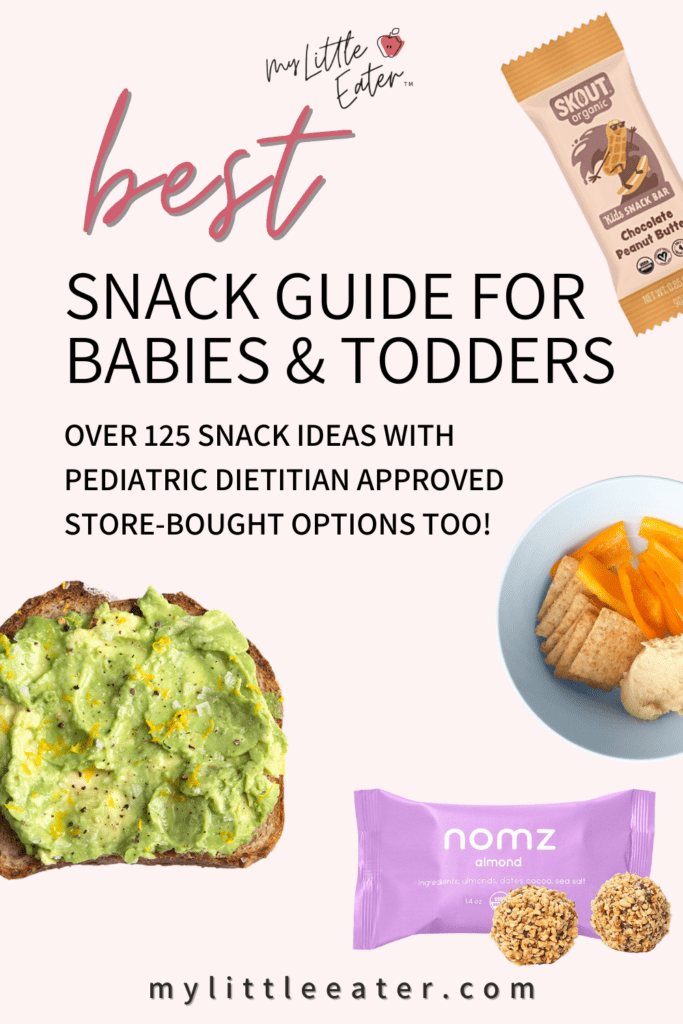
Table of Contents
When can I introduce sugar to my baby?
First off, sugar is naturally found in many healthy foods – including breast milk! In fact, natural sugars (meaning those bound within whole foods like fruit, milk, or grains) can be introduced as a whole food to babies as early as 6 months of age (more on this later in the blog).
However – added sugar – meaning sugar that is extracted from a whole food and added to another food, shouldn’t make up a big part of your baby’s diet.

The current guidelines about when to introduce added sugar to babies from the leading health organizations around the world are shown in the image below (1, 2, 3, 4, 5). Based on the current guidelines and recommendations from the health organizations listed below, the exact amount of sugar that is acceptable for babies and toddlers varies.
In general, all of these organizations agree that babies and toddlers should completely avoid or have very little amounts of added sugars before the age of two.
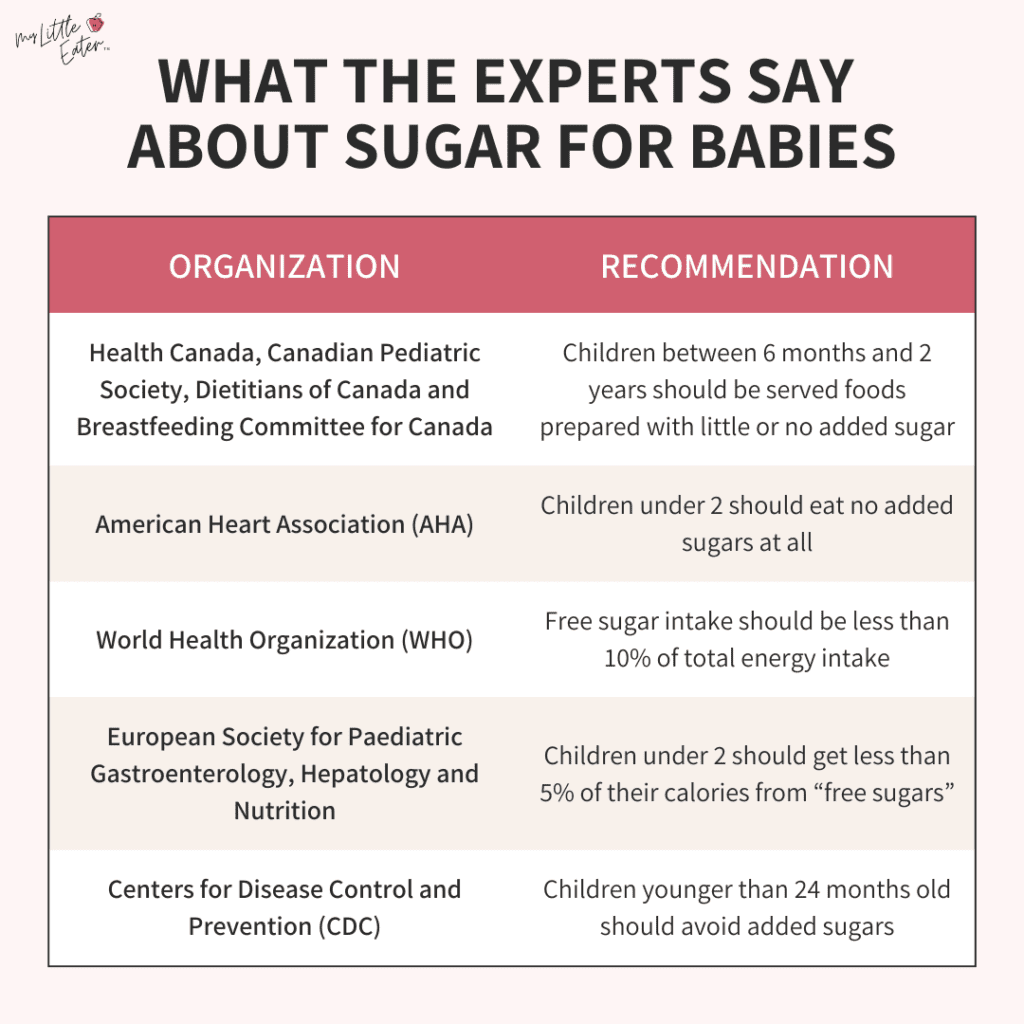
The main reason why you want to wait to introduce sugar to your baby is that sugar can take up precious space in your little one’s tummy. This leaves less room for nutrient-dense foods that they need to grow. Babies and toddlers require essential nutrients like fat, iron, protein, vitamins, and minerals in the first few years of life for optimal growth and development. None of these are found in added sugars.
MLE’s official recommendations on when to introduce added sugar
My Little Eater’s official stance is that added sugars should be avoided altogether until around 2 years of age and even sugar-free desserts or sweets should be limited or avoided.
Sugar-free cookies, cakes, ice cream, and more are becoming increasingly popular these days! Even though they’re “sugar-free”, the reason we recommend avoiding them is that they almost always have some type of artificial sweetener. This means that they’ll contribute to increasing your little one’s preferences for sweet-tasting foods (more on this later).
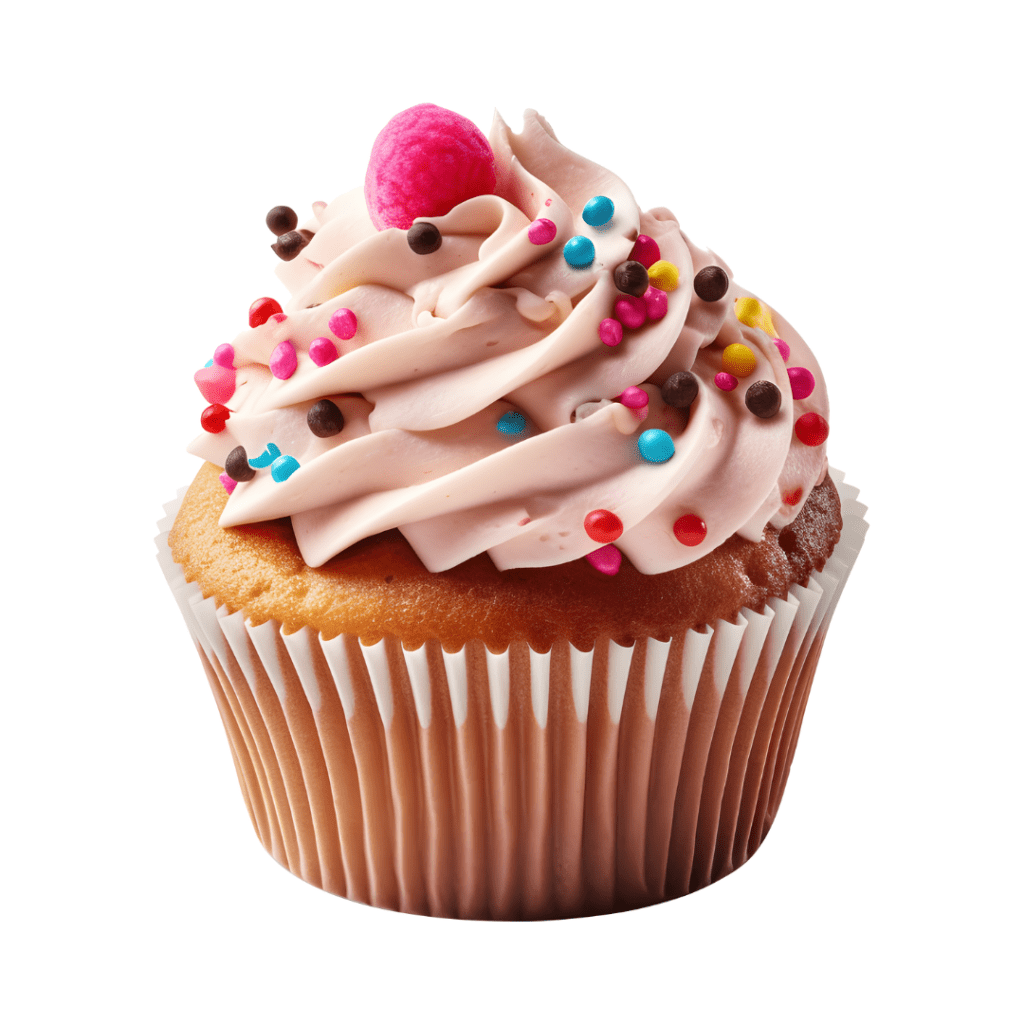
The first birthday cake smash is the exception of course! Even a random lick of an ice cream cone is not the end of the world – just try to be conscious of this overall.
If you can continue to hold off past 2 years of age, we highly encourage it. Base your decision on when to introduce added sugar and sweets on when your toddler actually starts to notice the sugary treats. Don’t base the decision on age alone.
The reason behind this is that we don’t want your child to notice these foods and feel like they’re deprived of them. This can lead to an obsession with the idea of them, which we want to avoid. Once they notice that they aren’t getting to enjoy sweet treats with the rest of the family you can begin to offer an appropriately sized portion for your toddler.

Our job as parents is to teach our toddlers how to manage sugar and sweets, not avoid them. You can learn more about how to raise a toddler to have a healthy relationship with sugar, here.
Now, this can be a lot easier to do if there isn’t an older sibling in the home who may introduce candy or sweets to them sooner than age 2. It’s ok – don’t stress about it and just do the best you can!
If your toddler notices those sweet foods earlier and you get the sense that they’re feeling left out, then allow them to eat it for the sake of building a long-term, healthy relationship with all foods. Being too strict around a set age isn’t needed!
The difference between sugar and added sugar
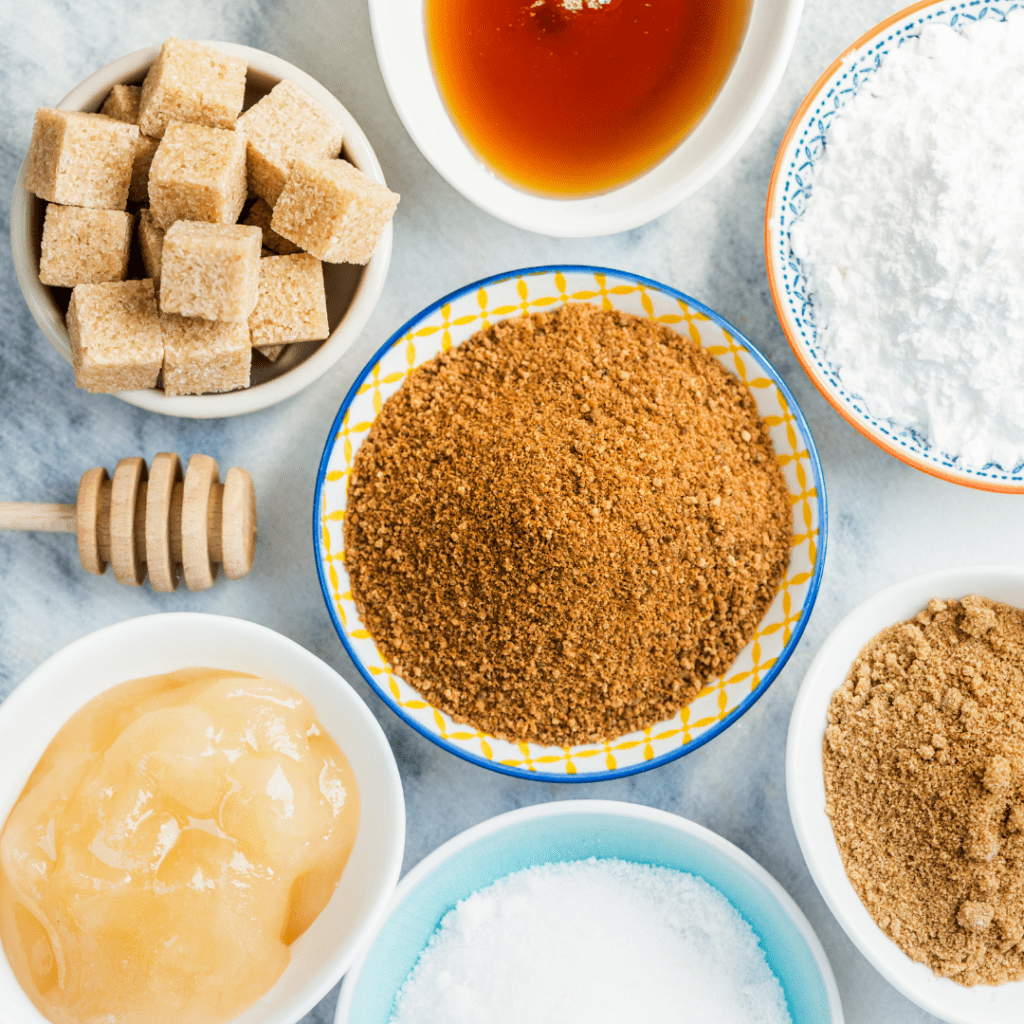
Let’s explore the difference between natural sugars and added sugar so that we’re all on the same page:
Natural sugar:
- Found in whole foods, in their whole form, such as fruits (fresh, frozen, or dried), vegetables (fresh, frozen, or dried), some grains, human milk, cow’s milk, and milk products (like plain yogurt).
Added sugars (or free sugars):
- When food is modified or processed to remove sugar from its whole form (to be used in something else or in some other way), that sugar is then considered to be added sugar (6).
- Added sugars are found in foods like fruit juices, fruit juice concentrates, soda, molasses, honey, agave, syrups, table sugar, candy, desserts, sweets, etc.
Is juice healthy for babies and toddlers?
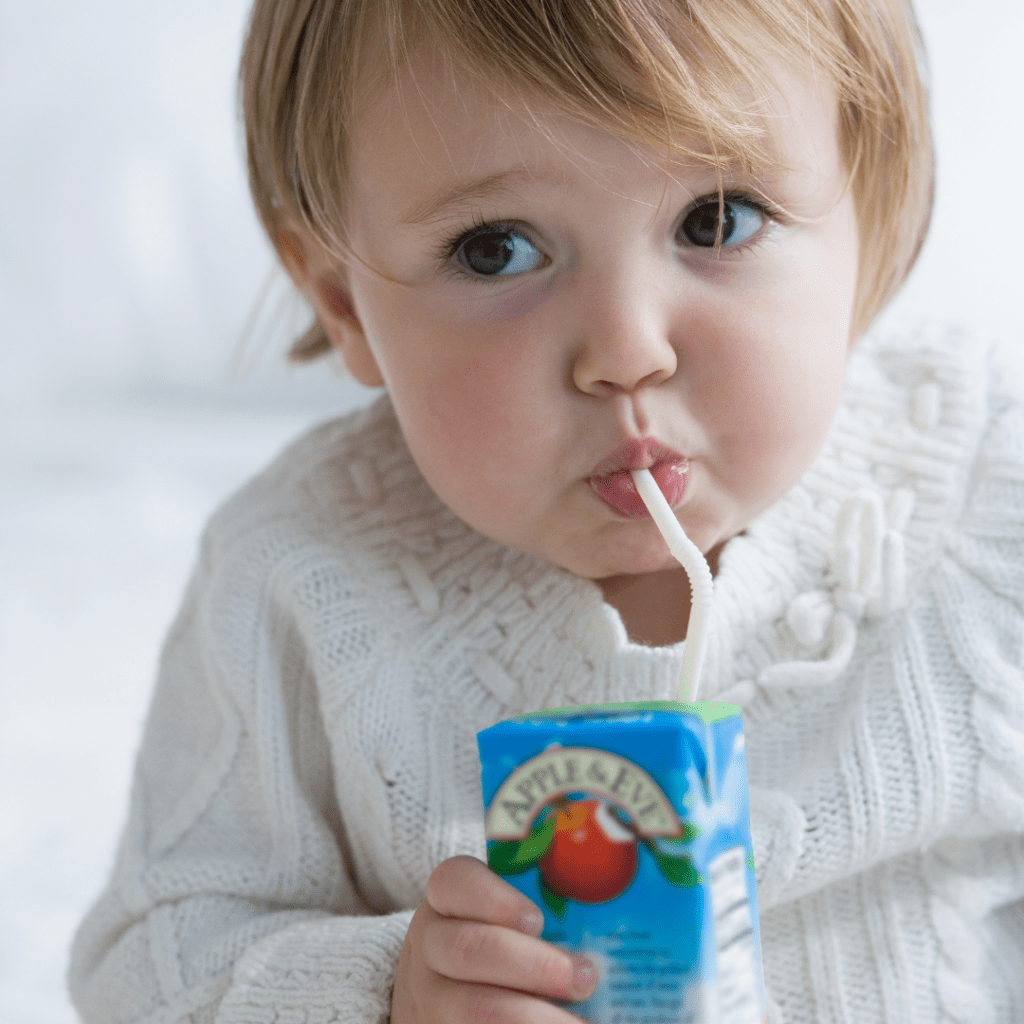
Fruit juice concentrate can be a bit confusing…it’s the concentrated form of fruit, so it must be healthy, right?
The big difference between fruit juices and whole fruits is that whole fruits are bound together with fiber, vitamins, minerals, and beneficial plant compounds like antioxidants. It’s not as easy to consume large amounts of sugar in one sitting, and the fiber helps balance blood sugar spikes more.
Fruit juice concentrate is actually a form of added sugar. To make it, whole fruits are crushed or blended to produce a pulp. This process means they are being stripped of their fiber and beneficial nutrients. Most of the water content is then extracted and evaporated (7). The outcome is a concentrated form of sugar (7).

For these reasons, we want to avoid giving fruit juices to your baby until at least 1-2 years of age (8). There are sometimes exceptions to this, such as offering diluted fruit juices (in a cup only) as a way to help with constipation. However, this should only be done as directed by a medical professional and under their supervision.
Whole foods and fruit should also be prioritized over store-bought fruit purees as they tend to have higher amounts of added sugar. Fruit purees containing added sugar are commonly found in premade baby food and baby or toddler pouches. To be clear, whole foods and fruits that are pureed at home in your blender are totally fine!
Are honey and maple syrup considered added sugars?

Honey and maple syrup are also confusing because they’re found in nature so they can’t be considered added sugars…right? Well, the problem is they are virtually all sugar. While they do contain some vitamins and minerals, ultimately, it’s a whole lot of sugar that is added to foods that would otherwise not be sweet. This increases the amount of sugar that would be consumed in a whole-food diet.
Why is sugar bad for babies?
Sugar-filled foods lack essential nutrients that your baby needs while growing at an exponential rate. Researchers have also determined that excess intake of added sugars causes increased affinity for sweet food in the long term, raises blood sugar, increases the occurrence of dental caries, and leads to other systemic health problems including obesity, diabetes, and cardiovascular diseases (9).
Let’s take a closer look at some of these concerns!
1. Increases their affinity for sweet foods

All of us are born with a strong preference for sweet taste. And that’s ok!
In ancestral times, sweet things signaled carbohydrates and energy – so it was the body’s natural survival mechanism to seek out and want to eat sweet-tasting foods.
That being said, we now live in a time where sweet foods and added sugars are found everywhere, and for the most part, we’re not in a food-scarce situation! In fact, added sugars are hidden in almost every packaged food purchased and are present at almost any event. The abundance in our environment means that the strong preference for sweet things isn’t serving us like it used to.

That’s why we don’t want to offer foods with added sugars to babies early on, especially during that critical period of 6 to 9 months, as this only deepens the preference for more sweet flavors (10).
We want babies to experience and learn to like the pure taste of meat and veggies that sometimes have more bitter flavors. Ultimately, this helps to reduce the chance of developing picky eating behaviors – especially in toddlerhood (10).
All humans are also born with the natural urge to reject more bitter foods (bitter is associated with poisonous foods). Therefore, taste preferences for foods we want our children to eat later in life, like vegetables, must be learned (9, 11)!
2. Leads to excess calories with no nutritional value

We also know that when foods with added sugars and minimal or zero nutritional value replace nutritious foods in your little one’s diet, it leads to a higher risk of developing negative health outcomes and chronic disease in the long term (6).
Added sugars influence weight gain in children due to excess calories without any nutritional benefits. Therefore, the more added sugars in your little one’s diet – the higher the risk of negative health outcomes like obesity, diabetes, and heart disease (6, 9).
At the end of the day, sugar is technically sugar (even sugar in whole fruits). It’s going to cause the same long-term effects, no matter what type of sugar you’re offering when offered in excess.
To be clear – when it comes to whole fruits (ie. natural forms of sugar) – excess is not “a really large portion of fruit at one meal”. When we talk about excess in this case we mean that they’re eating so much fruit that there isn’t room in their diet for things like protein, iron, healthy fats, and other essential nutrients. That’s going to be a concern with natural sugar, but with added sugar, that threshold for what is considered excess would be less.
3. Raises blood sugars
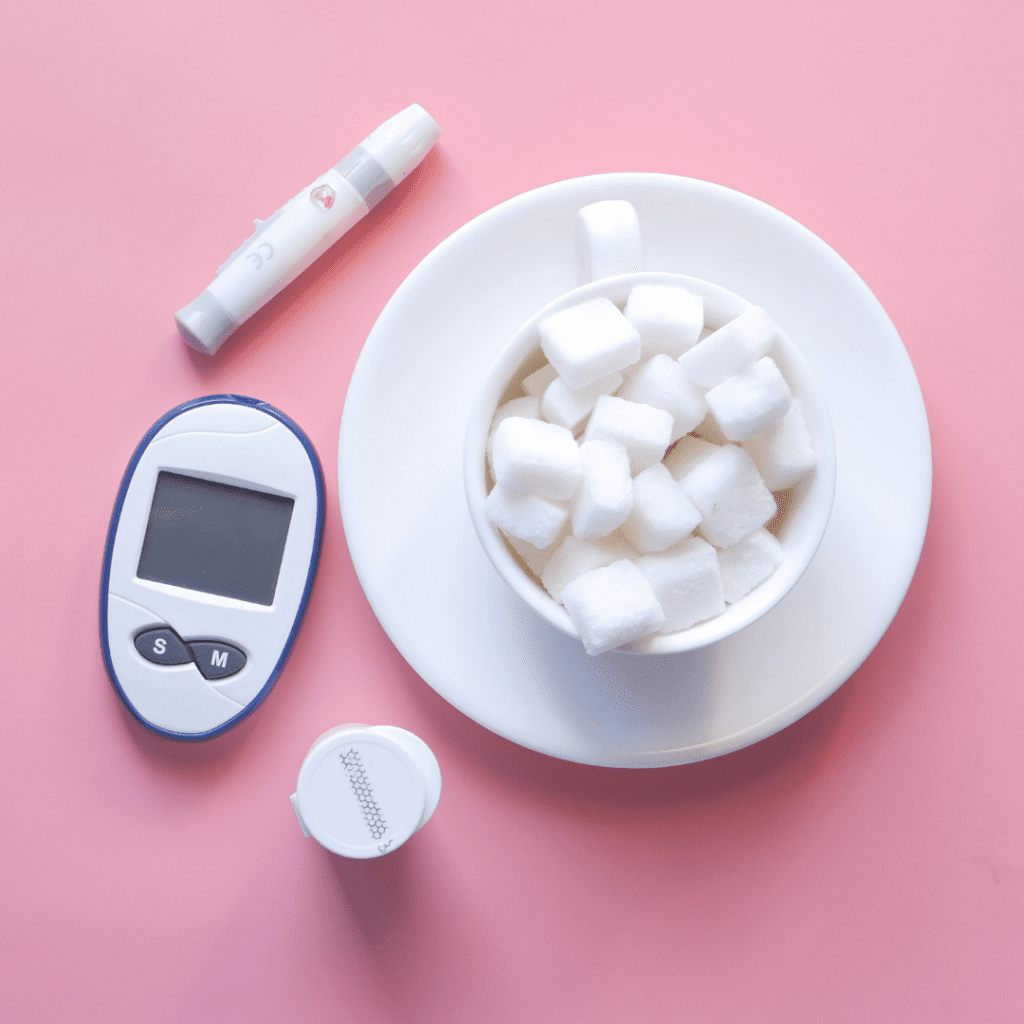
We’ve all seen what happens when a toddler has way too much sugar…absolute chaos! Then comes the crash.
Let’s take a quick look at the science behind it!
The explanation for this is a spike in blood sugar, which happens when sugar builds up in the bloodstream causing blood sugar levels to increase (12). Our body quickly releases insulin in response, turning the sugar we just ate into energy for our cells (12). This is why we see an increase in energy after consuming foods that contain sugar.
This is a totally normal process – the issue is when we eat too much sugar. When this happens, too much insulin gets released causing blood sugar levels to drop below normal resulting in a blood sugar crash.

If sugar is being offered, even if it’s something nutritious like an apple that has natural sugar, it’s important to balance it out with lots of fiber, protein, and fat. This is going to lower blood sugar spikes because fiber, protein, and healthy fats have a low impact on blood sugar levels as they require more time for digestion. You won’t see the same crash after having a lot of sugar when it’s eaten in conjunction with high amounts of protein, fiber, or fat.
Key Takeaway
On a more positive note, negative health-related conditions caused by the harmful effects of added sugars are totally preventable! Of course, we’ve got you covered on how to do just that. Let’s explore some tips on how you can limit and avoid added sugars for your baby or toddler.
How to limit or avoid added sugars for your baby
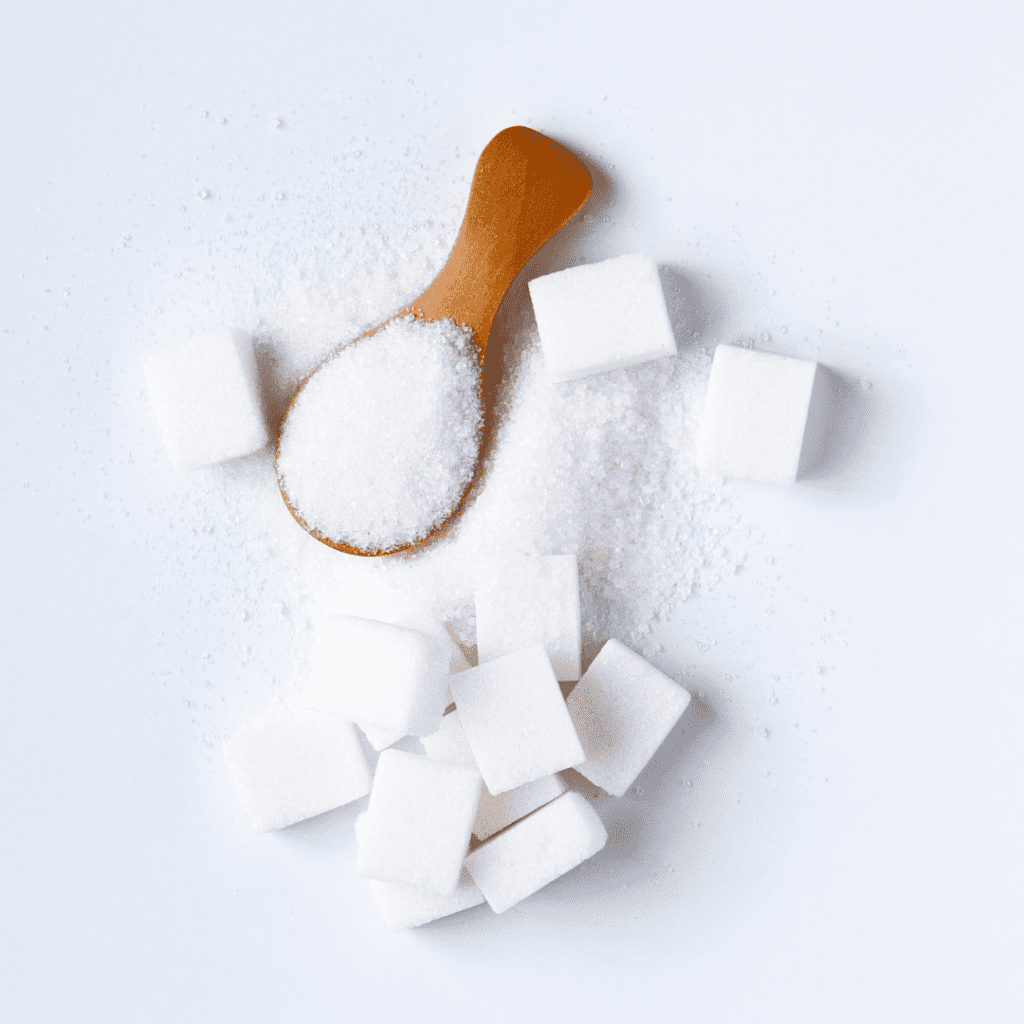
It can be tricky to avoid added sugars until 2 years of age because they’re found in a ton of different foods like cereals, yogurt, granola bars, and baby food, just to name a few. They’re even added to foods that aren’t really considered sweet like bread, pasta sauces, canned beans, ketchup, and more. As parents, we have to be extra cautious when buying pre-made and pre-packaged foods for our families.
That being said, your little one has probably already had a taste of added sugar here and there, but there’s no need to panic! We’re here to give you tips to help limit and avoid added sugar consumption in your baby’s diet from now on!
Identifying hidden sources of sugar
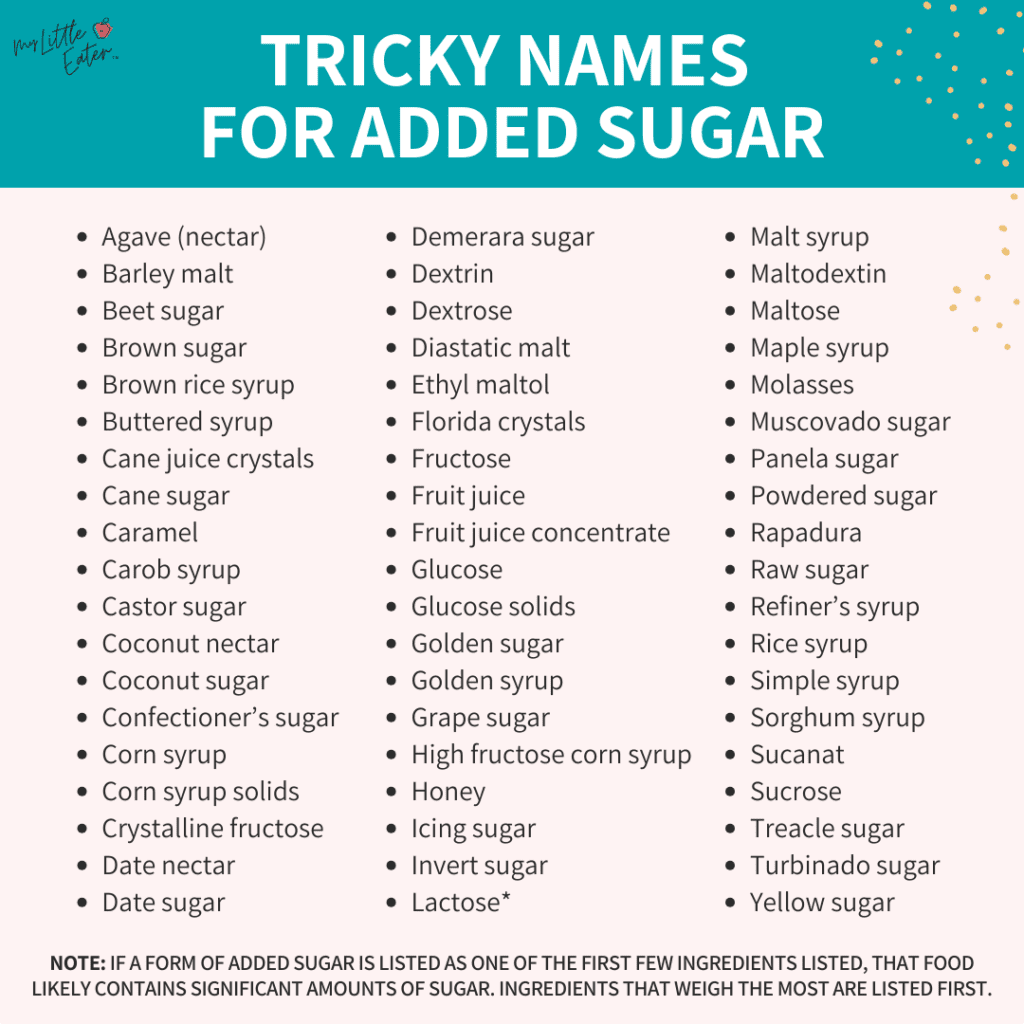
*Lactose: This is the naturally occurring sugar found in dairy products, like milk and yogurt. In these forms, lactose is not a concern. Manufacturers also use lactose as a form of added sugar in products such as confectionaries, cured meat, and others. If you notice it on something that is not a plain, unflavored dairy product, it’s being used as added sugar and should be avoided.
There are guidelines in place to ensure food manufacturers list all ingredients used in their products. However, as you can see in the image above, there are over 50 different names for sugar, which can make it incredibly difficult to identify them on an ingredient list.
Quick Tip:
Take a screenshot of the image above (or share it to your socials!) and refer back to it if you’re ever unsure of a suspicious ingredient that sounds like it could be a form of sugar!
We highly encourage you to take time to read nutrition labels and ingredient lists on packaged products before offering them to your baby or toddler. This way you can make more informed choices about what you’re serving to your baby and opt for a low-sugar version or avoid the food completely.
The image below shows where you can find the amount of added sugars compared to the total sugars on the nutrition facts table.
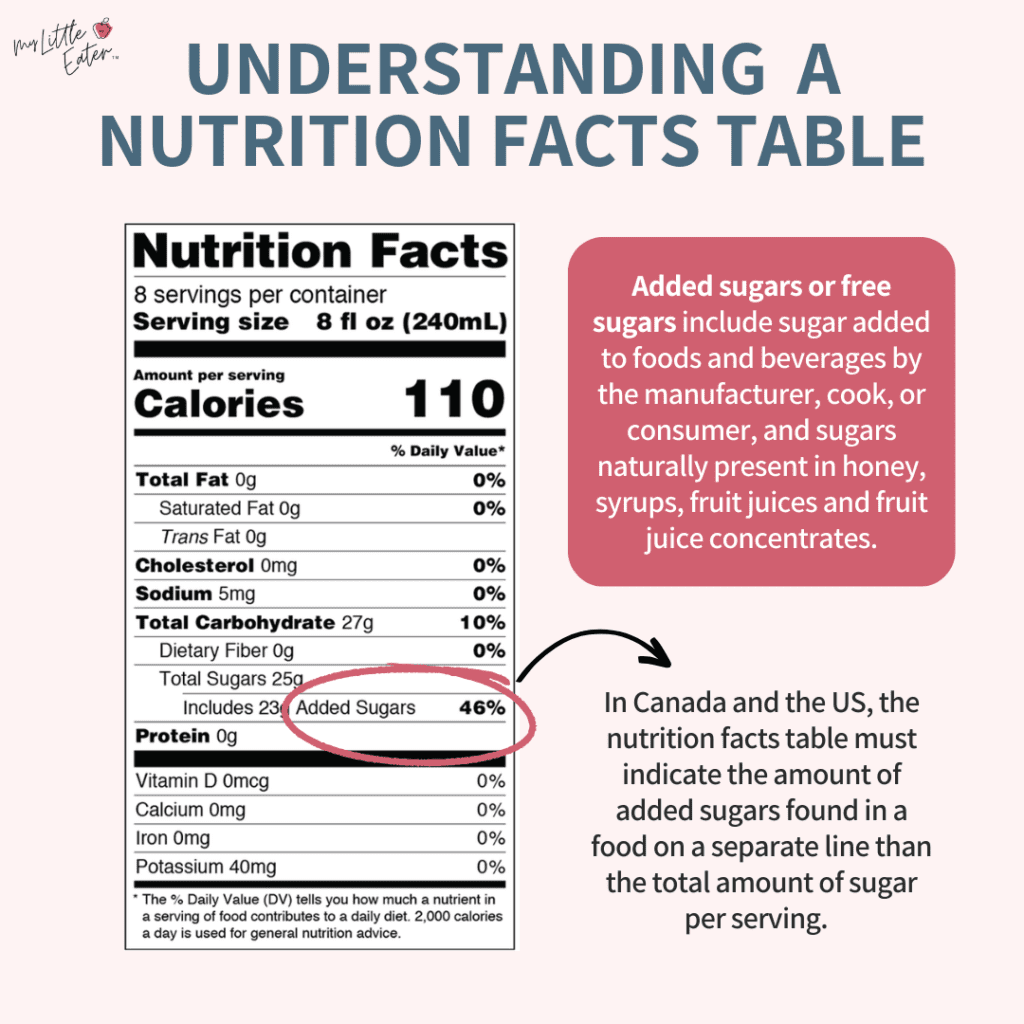
Keep in mind that manufacturers have found loopholes around this! For example, brown rice syrup in a granola bar may not be listed as an “added sugar” on the nutrition facts table because the syrup itself is sugar and no natural sugars are present. Therefore, it can be included in the “total sugars” category or it may be listed simply as “sugars”.
We know – this can get a bit confusing! If you don’t see the added sugar category on the nutrition facts table, take a closer look at the ingredients list to ensure there are no forms of added sugar.
Simple swaps to limit sugar
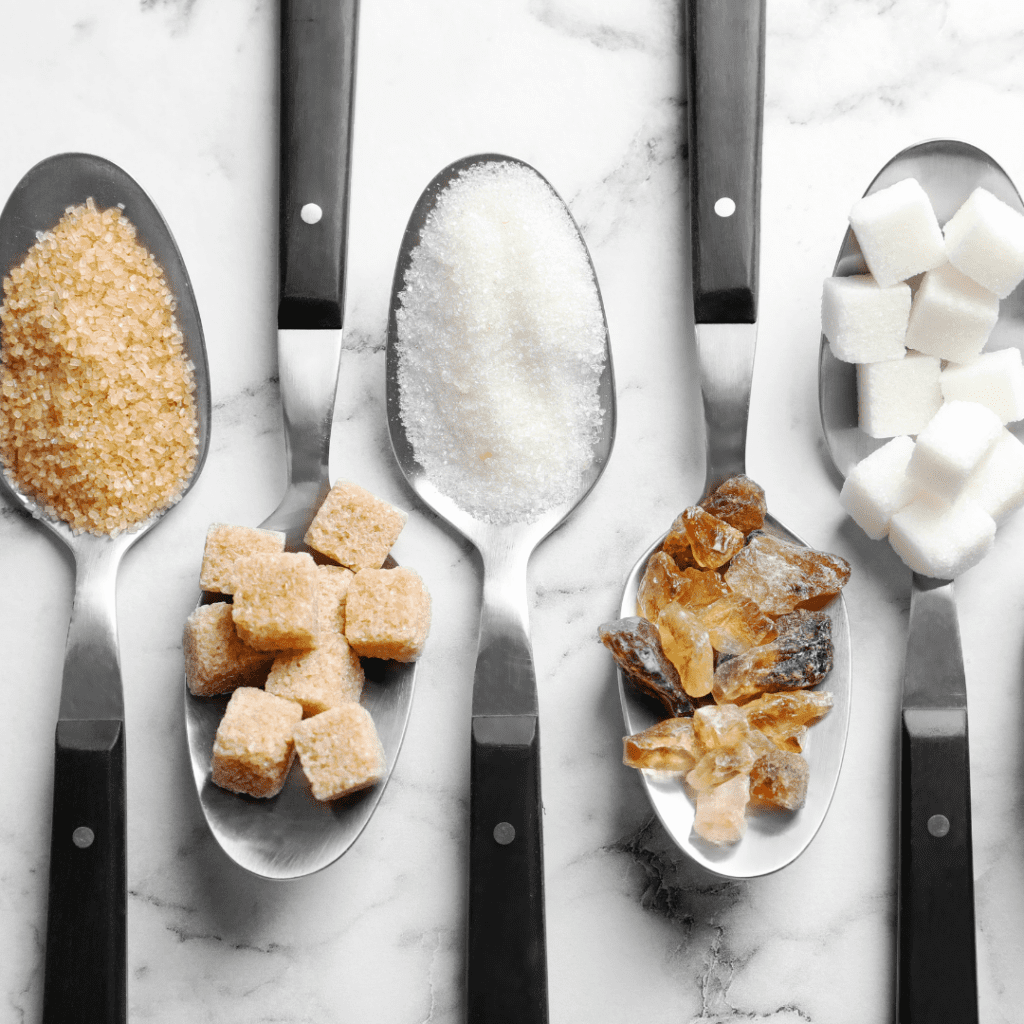
Significantly reducing the amount of added sugars in your little one’s diet doesn’t have to be complicated. Here are some easy swaps you can make starting today:
Don’t
- Don’t offer sugar-sweetened beverages.
- Don’t offer chocolate, vanilla, or other flavored milk products.
- Don’t offer store-bought flavored yogurt (which is most likely sweetened with fruit concentrate, or other added sugars/artificial sweeteners).
- Don’t offer chocolate, candy, or gummies (even if made with “real fruit”).
- Don’t use condiments like ketchup or BBQ sauce.
- Don’t add sugar, honey, or maple syrup when cooking/baking.
Do
- Do offer water or milk (or plain, unsweetened milk alternatives).
- Do offer plain, unsweetened milk products.
- Do offer yogurt plain for a tart taste or try it savory with nut butter or mashed sweet potato mixed in, or sweeten the flavor with real mashed fruit.
- Do offer freeze-dried fruit or fresh fruit.
- Do use plain yogurt, guacamole, or sugar-free ketchup as dips.
- Do offer baked goods with ripe bananas or dates, or impart a “sweet” flavor with vanilla extract or cinnamon.
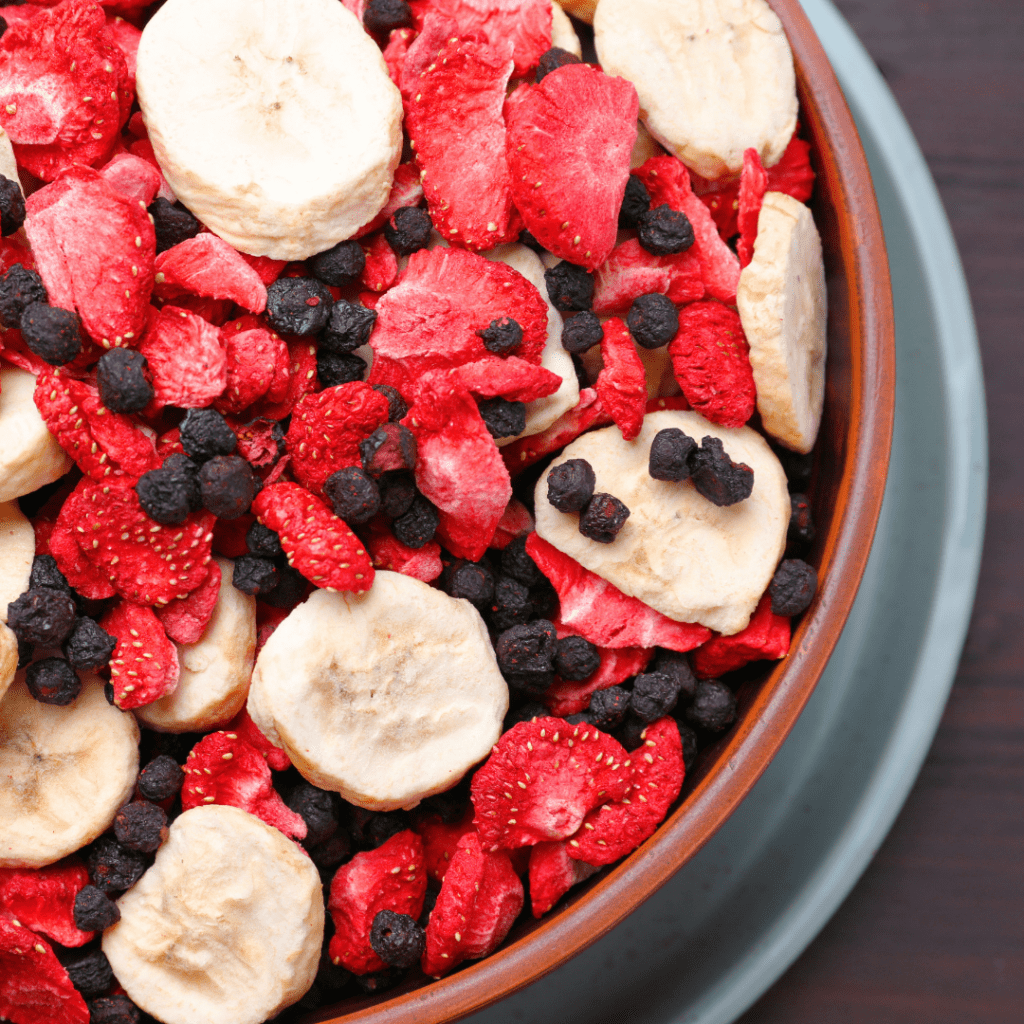
One of the many reasons why we absolutely love nomz organic bites is because they’re a convenient pre-packaged snack that doesn’t contain any forms of added sugar! Think of them like your child’s favorite two-bite chocolate brownies – but refined sugar-free.
They contain fat, fiber, and protein all rolled up in one delicious, nutrient-dense bite. The ratio of fat to sugar is great, with each ball containing 7 g of healthy fat, and only 3 g of natural sugar from Medjool dates. Each ball also contains 2 g of protein – further helping to balance those blood sugars and keep your toddler satiated much longer compared to a package of cookies, goldish, or gummies.

Balancing recommendations with the desires of others
You’ve probably already heard a friend or family member say “Oh come on – poor thing – just give them a taste!” when you chose not to offer a sugar-filled treat to your little one.
To which we say…they don’t even know what that is supposed to taste like! Or that it even exists!
Remember that your child doesn’t know what they’re missing!

Dealing with the topic of sugar around grandparents
We all know that grandparents love to spoil their grandchildren! Which is perfectly fine until it goes against how you want to be raising your baby. When it comes to sugar, and food in general, you can start by having a meaningful conversation with them even before your little one starts solids.
Let them know that you’re making healthy choices a priority and that avoiding sweets and added sugars is really important to you. Remind them that they can continue to spoil baby in lots of other ways that don’t involve food like extra cuddles, playtime, walks, stickers, books, etc!
Dealing with the topic of sugar around caregivers

Any caregivers in your child’s life, whether it’s a daycare or a family member, should understand and respect your decisions about not wanting to give your little one sweets or added sugars. Take the time to explain why it’s important to you and let them know how to navigate avoiding or limiting sugary beverages and foods.
This may result in you having to prepare lunches and snacks for your little one versus eating the foods prepared at a daycare facility or a family member’s home. If your child is at a daycare facility, you may have to deal with sweets being served on special occasions like birthdays, Christmas, Halloween, Easter, etc.
At the end of the day, it’s totally up to you if you want to let your little one enjoy treats on these occasions or holidays. There’s no judgment here! If you’d rather avoid all added sugars, let their caregivers know in advance and plan to send replacement snacks or healthy treats so your toddler doesn’t feel left out.
FAQs on sugar
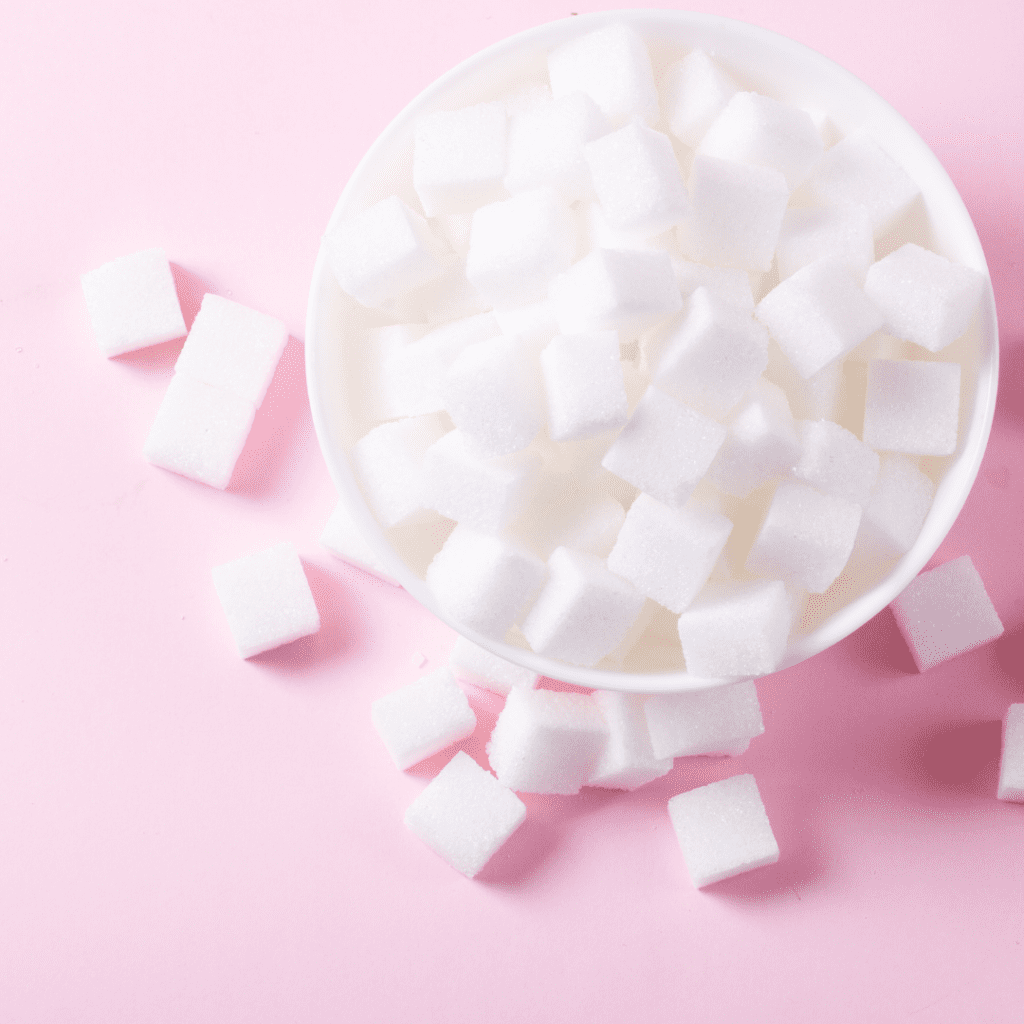
It’s totally your call if you want to give your baby a regular cake for their first birthday cake smash! Having cake one time isn’t going to affect them. That being said, if you want to skip the added sugar, we have a delicious smash cake recipe without any added sugar that you can check out, here.
It’s because of everything else found in whole fruit that it’s ok to offer it as part of a balanced, nutrient-rich diet for your baby. Fruit does contain natural sugars but it also provides fiber, vitamins, minerals, and beneficial plant compounds.
Fruit juices, such as orange juice, are commonly offered to kids when they have a cold or other flu-like illness because they provide hydration along with some vitamins and minerals. Unfortunately, fruit juices also provide a TON of added sugar – which is not beneficial for your sick baby. They need nutritious, immune-fighting, and hydrating foods, so we recommend skipping these sugary drinks.
Instead, ensure your baby or toddler is staying hydrated by offering breast milk, formula, or water more regularly (as needed). Check out our blog for a full list of foods and tips for your sick baby or toddler, here.
Chocolate typically contains high amounts of added sugars and sometimes caffeine. Therefore, we recommend following the same guidelines for chocolate as with added sugar and waiting until at least two years of age.
Sweeteners like monk fruit and stevia are naturally derived sweeteners that are generally accepted as safe for children. However, this is based on observation and not official research. Some people report digestive upset and gut issues when consuming different quantities of these sweeteners – so be aware of this and stop if you notice any symptoms.
Just because they’re safe doesn’t mean they should be a regular part of your little one’s diet. At the end of the day, they’re adding sweetness to a food that wouldn’t have been sweet otherwise. Again, this contributes to your little one’s affinity for sweet foods.
MLE-approved dessert for kids under age 2
Treats and desserts don’t have to be filled with sugar to be yummy and satisfying for your little one! Remember what we said earlier? Your baby doesn’t know what they’re missing out on if they haven’t been exposed to sugar-filled treats. To them, a naturally sweetened dessert with fruit will be just as delicious.
Try these Coconut Yogurt Banana Boats with the whole family! You can make them easier for your baby to eat by cutting the banana into bite-sized pieces and mixing everything together in the yogurt. Serve it on a preloaded spoon or let them dig in with their hands and get messy!
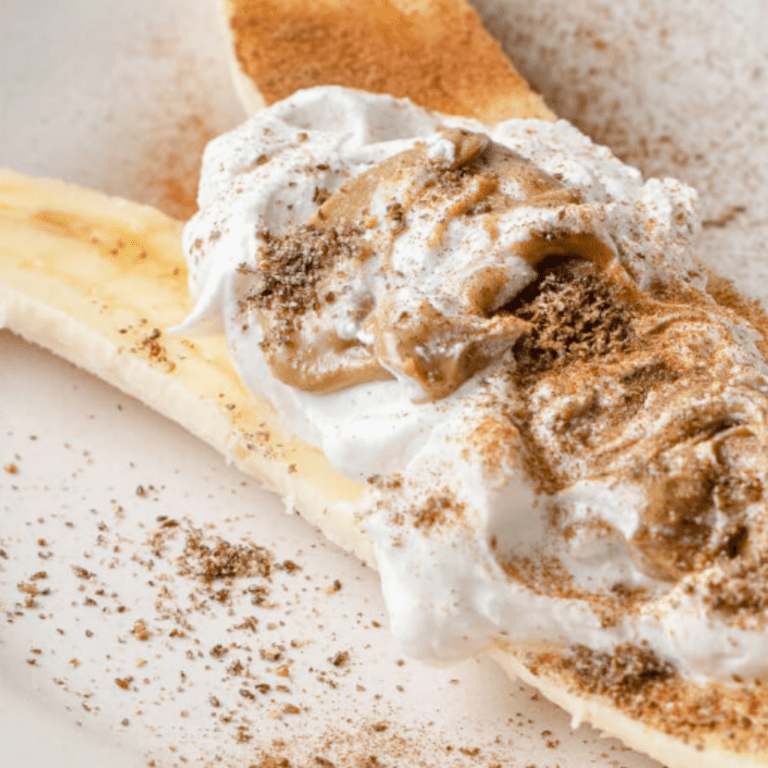
Coconut Yogurt Banana Boats
Ingredients
- 1 Banana (sliced in half lengthwise)
- ½ cup Unsweetened coconut yogurt
- 2 tbsp Sunflower seed butter
- 1 tsp Ground flax seed
- ¼ tsp Cinnamon
Instructions
- Place the banana onto a plate or into a bowl and top with coconut yogurt, sunflower seed butter, ground flax, and cinnamon. Enjoy!
Notes
Looking for more ideas for low-sugar, fun, tasty, mix-and-match snacks you can pull together in a jiffy for your baby or toddler? What about dietitian-approved pre-packaged snacks? Grab our snack guide for all the ideas and recipes you need!
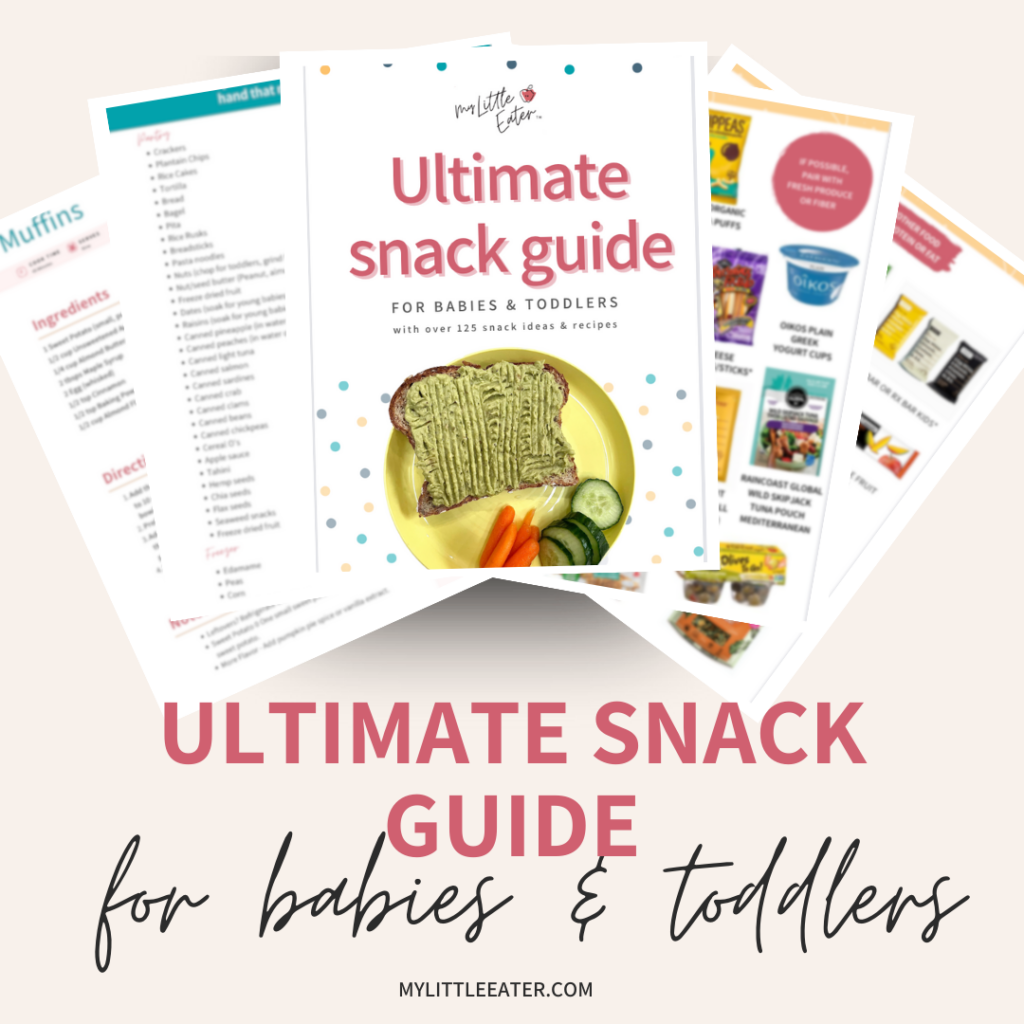
DID YOU FIND THIS HELPFUL? PIN IT TO SAVE FOR LATER!

References:
- Health Canada. Nutrition for Healthy Term Infants: Recommendations from Six to 24 Months. Retrieved from https://www.canada.ca/en/health-canada/services/canada-food-guide/resources/nutrition-healthy-term-infants/nutrition-healthy-term-infants-recommendations-birth-six-months/6-24-months.html
- Vos, M. B., Kaar, J. L., Welsh, J. A., Van Horn, L. V., Feig, D. I., Anderson, C. A., … & Johnson, R. K. Added sugars and cardiovascular disease risk in children: a scientific statement from the American Heart Association. Circulation, 135(19), e1017-e1034, 2017.
- World Health Organization. Guideline: sugars intake for adults and children. World Health Organization. 2015.
- Fidler Mis, N., Braegger, C., Bronsky, J., Campoy, C., Domellöf, M., Embleton, N. D., … & Fewtrell, M. Sugar in infants, children and adolescents: a position paper of the European society for paediatric gastroenterology, hepatology and nutrition committee on nutrition. Journal of pediatric gastroenterology and nutrition, 65(6), 681-696, 2017.
- Centers for Disease Control and Prevention. Food & Drinks for 6 to 24 months old. Food and Drinks to Avoid or Limit. 2023. Retrieved from https://www.cdc.gov/nutrition/infantandtoddlernutrition/foods-and-drinks/foods-and-drinks-to-limit.html
- Paglia, L., Friuli, S., Colombo, S., & Paglia, M. (2019). The effect of added sugars on children’s health outcomes: Obesity, Obstructive Sleep Apnea Syndrome (OSAS), Attention-Deficit/Hyperactivity Disorder (ADHD) and chronic diseases. Eur J Paediatr Dent, 20(2), 127-32.
- Adnan, A., Mushtaq, M., & ul Islam, T. Fruit juice concentrates. In Fruit Juices (pp. 217-240). Academic Press, 2018.
- Heyman, M. B., Abrams, S. A., Heitlinger, L. A., Cabana, M. D., Gilger, M. A., Gugig, R., … & Schwarzenberg, S. J. Fruit juice in infants, children, and adolescents: current recommendations. Pediatrics, 139(6), 2017.
- Chi, D. L., & Scott, J. M. (2019). Added sugar and dental caries in children: a scientific update and future steps. Dental Clinics, 63(1), 17-33.
- Harris, G., Mason, S. Are There Sensitive Periods for Food Acceptance in Infancy?. Curr Nutr Rep 6, 190–196, 2017. https://doi.org/10.1007/s13668-017-0203-0
- Swan, G. E., Powell, N. A., Knowles, B. L., Bush, M. T., & Levy, L. B. (2018). A definition of free sugars for the UK. Public health nutrition, 21(9), 1636-1638.
- DiNicolantonio, J. J., & O’Keefe, J. H. (2022). Added Sugars Drive Insulin Resistance, Hyperinsulinemia, Hypertension, Type 2 Diabetes and Coronary Heart Disease. Missouri Medicine, 119(6), 519.

ABOUT THE AUTHOR
CHELSEY LANDRY, RD
Community Dietitian at My Little Eater Inc., and bunny-mom to Hickory. Chelsey offers one-on-one counselling to parents of babies and toddlers that need more customized support. Learn more by booking a free discovery call with her today!

ABOUT THE AUTHOR
CHELSEY LANDRY, RD
Community Dietitian at My Little Eater Inc., and bunny-mom to Hickory. Chelsey offers one-on-one counselling to parents of babies and toddlers that need more customized support. Learn more by booking a free discovery call with her today!









